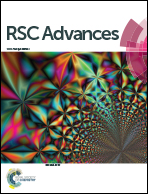Enhanced near infrared persistent luminescence of Zn2Ga2.98Ge0.75O8:Cr0.023+ nanoparticles by partial substitution of Ge4+ by Sn4+
Abstract
Spinel-phase Zn2Ga2.98Ge0.75–xSnxO8:Cr0.023+ (ZGGSO:Cr3+) nanoparticles with various Sn4+ concentrations were prepared by a hydrothermal method in combination with a post-annealing in vacuum at high temperature. For these nanoparticles, the observed near infrared (NIR) persistent luminescence peaked at ∼697 nm and originates from the 2E, 4T2 (4F) → 4A2 transitions of Cr3+ and the afterglow time exceeds 800 min. For both the interior and surface Cr3+ ions in the ZGGSO host, it can be found that the increased energy transfer from Cr3+ to the deep trap (anti-site defects,  ) after the substitution of Ge4+ by Sn4+ plays a key role in enhancing the persistent luminescence of the ZGGSO:Cr3+ nanoparticles. Strikingly, this energy transfer process can be controlled through the variations in the crystal field strength and the trap depths. Our results suggest that not only Sn4+ substitution can improve in vivo bioimaging but also the existence of deep traps in ZGGSO:Cr3+ nanoparticles is helpful for retracing in vivo bioimaging at any time.
) after the substitution of Ge4+ by Sn4+ plays a key role in enhancing the persistent luminescence of the ZGGSO:Cr3+ nanoparticles. Strikingly, this energy transfer process can be controlled through the variations in the crystal field strength and the trap depths. Our results suggest that not only Sn4+ substitution can improve in vivo bioimaging but also the existence of deep traps in ZGGSO:Cr3+ nanoparticles is helpful for retracing in vivo bioimaging at any time.



 Please wait while we load your content...
Please wait while we load your content...